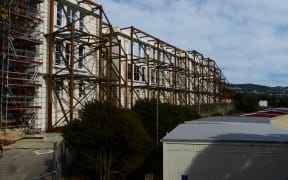Some children could find themselves learning in hallways, staff rooms and other makeshift classrooms this year because overcrowded schools don't have enough space.

Some schools are struggling to find space for all their enrolled pupils. Photo: 123RF
Schools are starting to reopen from today and principals in some regions said they would not have enough classrooms for all the children they expected to enrol this year
Areas understood to be at or close to capacity this year include parts of Waikato, Bay of Plenty, Kapiti, Canterbury and Queenstown.
In most of those areas, the government has built new schools and new classrooms in recent years, and nationally it announced school building projects worth hundreds of millions of dollars in the past 18 months.
However, principals told RNZ News they were still struggling to find enough space.
The chairperson of the Waikato Primary Principals Association, Hamish Fenemore, said schools in Hamilton, Cambridge and other parts of Waikato had been taking drastic action to fit in all the children they're enrolling.
He had heard of classes happening in hallways and staff rooms.
"There's old dental clinics that have been pulled apart and been used for teaching spaces now. The biggest one that you're hearing of is a lot of libraries that have been converted."
Mr Fenemore, who is principal of Cambridge East School, said schools were working on the problem with the Education Ministry, though the ministry said schools in Cambridge had enough space for the town's children.
"We're looking at the capacity that's already within the area and making sure that all areas are being fully utilised before they spend the big money on either putting in new schools or putting in extra classrooms," he said.
Mr Fenemore said the ministry preferred to make sure a school's growth was sustained, and not just a flash-in-the-pan, before it committed to spending money on new rooms.
Tauranga schools at the limit
The president of the Western Bay of Plenty Principals Association, Dane Robertson, said most schools in Tauranga and the surrounding area expected to start the year at the limits of their maximum rolls.
"About 60 percent of the schools are going to be starting at capacity on day one and another 20 percent are over capacity on day one," he said.
"Obviously what that means is more students in each classroom and there's some schools they no longer have a library because that's been converted into a makeshift classroom. Lot of areas that would be used for perhaps music or art also have been coverted."
Mr Robertson said schools tried not to have large numbers of children in each classroom, but sometimes that was hard to avoid.
He said the Education Ministry was running to catch up with Tauranga's growth and principals understood there was only so much money available to build new classrooms and schools.
"Obviously Auckland's growing, a lot of money went to Christchurch which is understandable after the earthquakes." he said.
Mr Robertson said many schools in the city were no longer accepting out-of-zone enrolments.
On the Kapiti Coast, the principal of Waikanae School, Bevan Campbell, said he was expecting to run out of classrooms within a few months.
"I know that Waikanae School will be short of one classroom come July," he said. "Probably we will have to put kids in the hall or put kids in the library."
Mr Campbell said Waikanae's two other schools were also full, but the Education Ministry was not keen to build more classrooms because its projections, which he did not agree with, indicated there would not be much more growth.
Population growth in Rangiora
The principal of Ashgrove School, Christine Chadwick, said schools in the Rangiora area had been growing rapidly because of families leaving quake-hit Christchurch and, more recently, due to people moving from all over New Zealand and overseas to work on the Christchurch rebuild.
Mrs Chadwick said her school was so full it had been using its hall and library to house classes, but it would start this year with a new $4.8 million building that replaced some classrooms and provided three new ones.
But she said that even with the new rooms, the school would soon reach its capacity.
"To start the year we'll have enough. I think as the year progresses we will definitely still be possibly one classroom short," she said.
Mrs Chadwick said three other schools in the area were also getting new classrooms to increase their capacity, but they were likely to fill up quickly.
A school that is keeping ahead of the roll-growth curve is Wakatipu High School in Queenstown.
It is moving to a brand new site next year and the principal Steve Hall says it will be just in time.
"We're going to be pretty full here this year, but we know we only have to be here one more year before we move to our new school."
Mr Hall said the new school was being built for 1200 students, but the government had agreed to fast-track the second phase so the school could take a total roll of 1800 students.
He said Queenstown had been growing for some time and it was affecting all the schools in the area.
"The primary schools are growing really quickly as well and there are issues for some of them."
Ministry funding
The head of the Education Ministry's education infrastructure service, Kim Shannon, said the national average figure for school capacity was 85 percent.
The highest average was 90 percent for schools in the region served by the ministry's Canterbury office, with Auckland and the region served by the ministry's Lower Hutt office at about 87 percent.
Ms Shannon said the ministry worked hard to ensure there was enough space to accommodate every child in every region.
"In the last two years, more than $470m has been allocated to fund more capacity for schools around the country," she said.
That money included funding for more than 700 new classrooms, the expansion of four existing schools and seven new schools.
"As a result of the Auckland roll growth programme, school redevelopments, new schools and the projects green-lighted so far under Budget 2016, we will deliver more than 17,000 new student places by 2019."
Ms Shannon said the ministry planned carefully for roll growth, using Statistics New Zealand data as its main source for forecasting.
"We work closely with schools that are close to capacity to either help them manage their rolls more effectively, or to provide them with more classrooms."
She said the ministry could make sure there was room for all students by implementing enrolment schemes so schools with spare capacity balanced out schools that were under pressure, providing more classrooms, and building new schools.
"Some schools may be at capacity because they are accepting students from outside their enrolment zone or because they have international students, neither of which are funded for classroom space. They can do this but need to ensure that there is enough room for all students to continue to learn comfortably."




